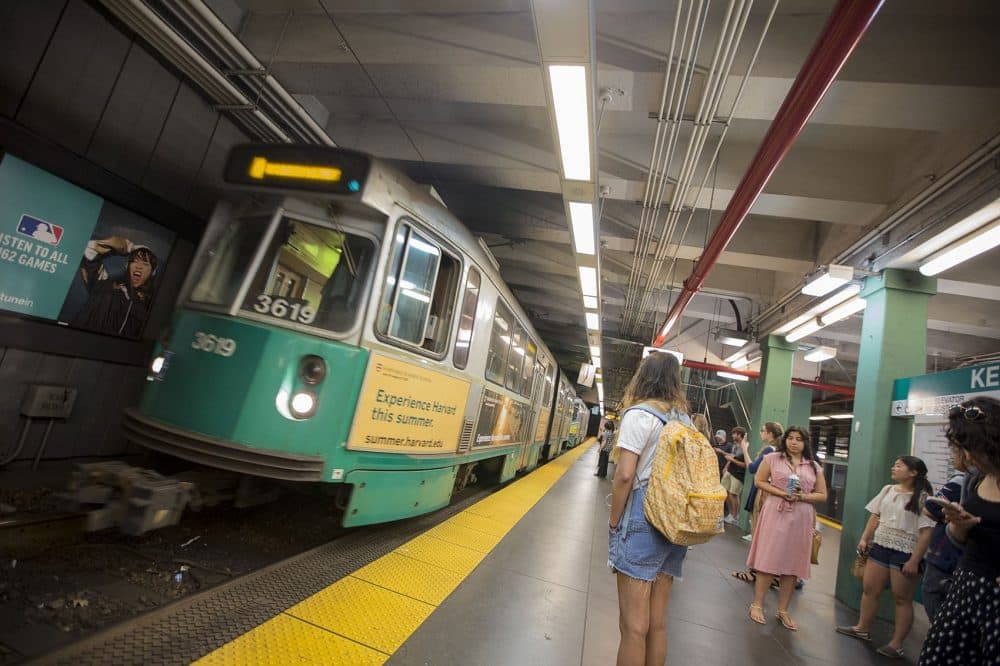Advertisement
Advocates Say MBTA Riders Need Accessibility Now, Not Later

The T is becoming more accessible, but not fast enough for some advocates who say people with disabilities need the improvements now.
At a public meeting on Monday, a representative from the MBTA’s Plan for Accessible Transit Infrastructure (PATI) presented data from every T stop, bus stop and commuter rail station. The presentation showed that 84 percent of the MBTA’s nearly 8,000 bus stops have at least one significant barrier to accessibility, like a curb with no ramp.
More than 30 commuter rail stations remain inaccessible, and so are five subterranean T stations and 32 street-level stops, most of them on the Green Line.
"Like everything else that we think about with public transportation in Massachusetts, the money is short and issues to solve are big."
Wendy Landman, of WalkBoston
“I think that it’s a true statement that the T is more accessible than it has been previously, but it doesn’t mean it is accessible, and I think that’s a key difference,” says Stacy Thompson, the executive director of LivableStreets, a transit advocacy group.
Thompson says she understands that a fully accessible T is years away. But she would like the MBTA to speed up the process with smaller projects — like installing shelters at bus stops. Those improvements should be integrated into other new initiatives, she says, such as a project that has crews working day and night to clean and repaint dingy T stops.
MBTA officials have laid out priorities for the next 20 years, with a focus on improving stops with the highest ridership. Some of the recommended improvements are already underway, including the closure of more than 140 inaccessible bus stops with low ridership — sometimes fewer than five riders per day, on average. Hundreds more bus stops are slated to be reconstructed or redesigned.
On a larger scale, the MBTA has several multimillion-dollar station renovation projects planned in the coming years. The Red Line will become completely accessible for the first time this summer, when Wollaston Station in Quincy reopens after a renovation.
Advertisement
But MBTA officials say some accessibility problems are outside their power to change.
Laura Brelsford, who presented the accessibility findings on Monday, says improving accessibility will be impossible without cooperation between the MBTA and the cities and towns it serves.
“It’s really important to be aware and to note that 99 percent of our bus stops are located on municipal sidewalks or adjacent to municipal curb ramps,” she says in an online video of the presentation. “In order to address almost 8,000 stops, we’re really going to need to find ways to empower the cities and towns to address those sidewalk and curb ramp issues.”
Empowerment could come in the form of local, state and federal grants, Brelsford says.
Wendy Landman, the executive director of WalkBoston and a consultant on PATI, praises the MBTA’s progress but acknowledges the project has barriers.
“Like everything else that we think about with public transportation in Massachusetts, the money is short and issues to solve are big,” Landman says.
In the meantime, those big issues continue to affect people with disabilities, advocates say.
Carol Steinberg, an attorney, writer and disability activist, lives near the Forest Hills stop on the Orange Line. Although she stresses that service has improved, she says she avoids the T. She worries that elevators will be out of service, or that no employees will be around to put down the ramp that helps her wheelchair cross the gap between the train and the platform.
“When I take it, I’m happy I took it. It works," she says. "But I’m nervous about it, so I drive.”
To get her to use the T more often, she says the MBTA must keep getting better.
“Keep doing what they’re doing, but speed it up,” says Steinberg.